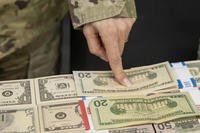If you are carrying consumer debt, like a credit card balance, personal loan, or overdraft protection balance, you are not alone. While the calculations vary, somewhere around 50% of Americans have consumer debt that they don't pay off each month. Most experts agree that paying off that debt should be a high priority. But how do you motivate yourself to do it? Here are three steps that might just help you find a way to get rid of that debt:
1. Make a list of every interest accruing debt that you have. Include the balance, the interest rate, the minimum payment and, most importantly, the amount of interest that you are paying each month. Take a moment to think about how you feel about that money, both the payment and the amount of interest you are paying each month. What could you do with an extra $40 per month? (That's just an example, of course.) You could save it, you could maybe buy a nice steak instead of hamburger, you could get a babysitter for some time without your kids. What kinds of things make you feel really happy when you think about what you could do with that money?
2. Make some sort of a plan, and then make a visual to help you see what you are trying to do. I like to total up the amount I owe (rounding it to a nice, even number) and make a chart that shows how and when I plan to pay for it. Here's what an example might look like: (The big red turtle is my car, if you were wondering.)

I used $300 increments because that seemed like a reasonable amount to be able to pay off at once, enough that it would make fast progress but not so much that it would be overwhelming.
You don't have to use my kid-style chart, though. Some people take a big glass jar and fill it with poker chips to represent their debt. More debt, add some chips. Pay some off, take some out. Or you can show your debt using Monopoly money. Using it as a dining room center piece or desk paperweight will remind you of your goals. The downside to chips or monopoly money is that you can't assign planned days, but it will still work. Another idea I've heard is to get a 100 piece puzzle from the thrift store or dollar store, break your debt down into 100 increments, and add a puzzle piece for every chunk you pay off. This one wouldn't work for me, as it would become a kid toy, but it might work for some of you.
3. Make a way to remind yourself of your goal. If you need to put a chart on your refrigerator, do it. Wrap a post-it around your credit card with a picture of a nice dinner on it. Find a friend who is also trying to pay off their debt and keep each other motivated. Hang a poker chip from your rear-view mirror. Whatever creative thing you can think of, do it.
Using these three steps, you should be able to make and implement a plan to get out of debt. It might not be easy, but it will be worth it.








